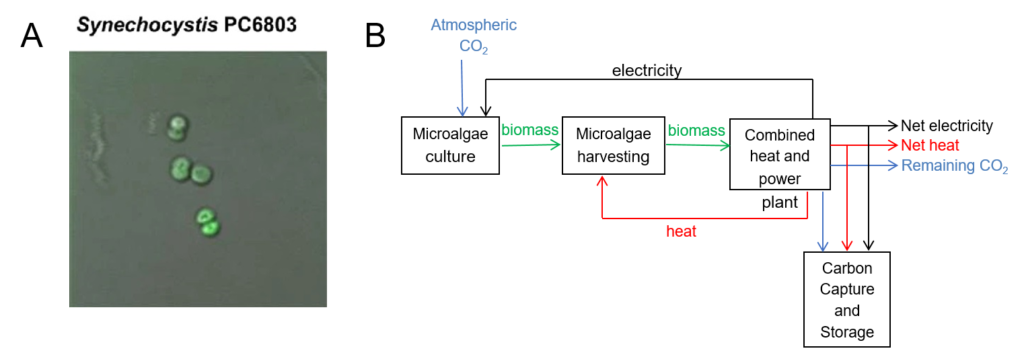To achieve carbon neutrality, it is necessary not only to reduce our CO2 emissions, but also to capture atmospheric CO2, namely to realize “negative emissions”. Researchers have conducted a “thought experiment” to quantify a negative emissions technique based on the use of microalgae.
There are currently two types of negative emission technologies. Direct air capture uses physical-chemical processes to remove CO2 from the atmosphere, while indirect capture relies on photosynthesis, primarily using CO2 absorption by plants. In the so-called Bioenergy with Carbon Capture and Storage (BECCS) technique, these plants are then harvested and dried before being burned in a thermal power plant, producing electricity and/or heat. The combustion emits CO2, which is captured and geologically stored. On the whole, CO2 is therefore removed from the atmosphere. The BECCS technique is already considered in the IPCC reports, but only for plants. Conversely, microalgae (Figure a) are photosynthetic microorganisms with a high potential since they perform half of the photosynthesis on a global scale. Moreover, they absorb CO2 more efficiently during growth than plants. Researchers from the Solid State Physics Laboratory have therefore considered a new negative emission technology by indirect capture based on the use of microalgae (Figure b). These results have just been published in Energy Nexus.
In order to reach carbon neutrality, it will be necessary to capture 10 Gt of CO2 per year in 2050. If we assume to use only plant-based BECCS to achieve this goal, it is necessary to devote 15% of the current world agricultural area, which seems largely unrealistic. For the same objective, a factor of 4 to 8 on the surface is obtained with the microalgae according to the productivity of these (biomass produced by unit of time and surface used). Even if the water consumption remains too high in the BECCS process, the use of some microalgae growing in sea water could solve this problem.
The process also produces energy, allowing us to study its energy efficiency, especially in terms of electricity. For low productivity values, the use of microalgae consumes electricity, in a way comparable to direct air capture (another very energy-intensive negative emission process): indeed, for a productivity of 15 g.m-2.day-1, BECCS with microalgae would consume 0.8 GJ per ton of CO2 captured, while direct capture consumes 0.9 GJ. On the other hand, the process is profitable (net positive electricity) for high productivity values, comparable to other renewable energy sources such as wind turbines: the BECCS system with microalgae would produce 0.25 W/m2 for a productivity of 30 g.m-2.day-1, compared to 0.2 to 0.5 W/m2 produced by wind turbines. Note that in the case of biofilms, a reasonable value of productivity is 15 g.m-2.day-1, which corresponds exactly to the case where the BECCS process consumes as much energy as it produces. These results open up new avenues for re-thinking the removal of atmospheric CO2, if possible in a low-cost manner.

Figure. A) Optical microscopie picture of Synechocystis sp. PCC6803 microalgae; B) Principle of microalgae-based BECCS. Microalgae are grown through atmospheric CO2, the corresponding biomass is then fired in a combined heat and power plant, thus producing heat and electricity; the CO2 resulting from the combustion is captured and stored; following the blue arrows corresponding to CO2, one can easily see that the process is on the whole a Negative Emission Technology. The growth of microalgae needs electricity, taken from the energy generated by the power plant.
Reference
Microalgae-based Bioenergy with Carbon Capture and Storage quantified as a Negative Emissions Technology
C. Even, D. Hadroug, Y. Boumlaik, G. Simon
Energy Nexus, 2022, 7, 100117
DOI: 10.1016/j.nexus.2022.100117
Contact
Catherine Even
